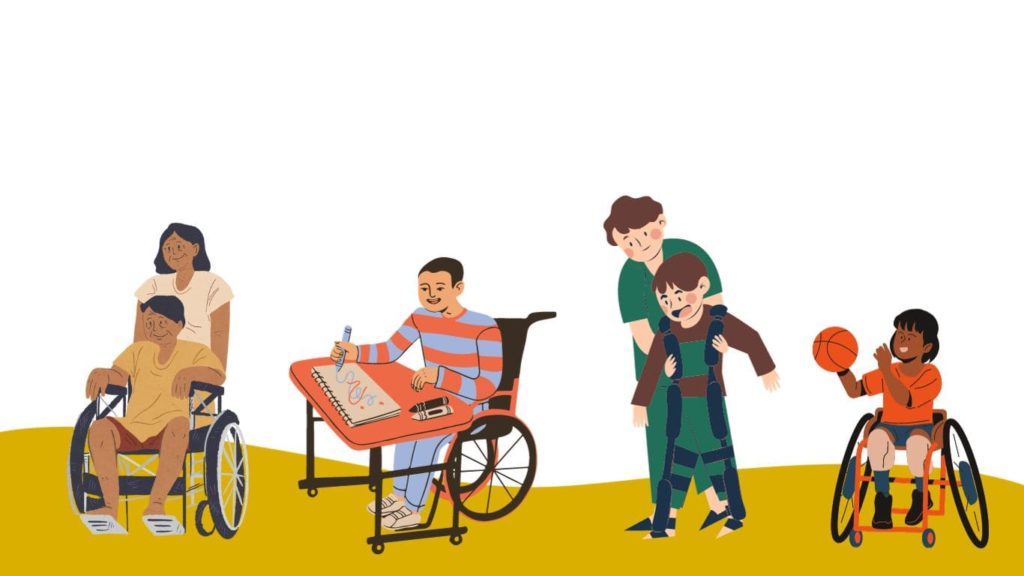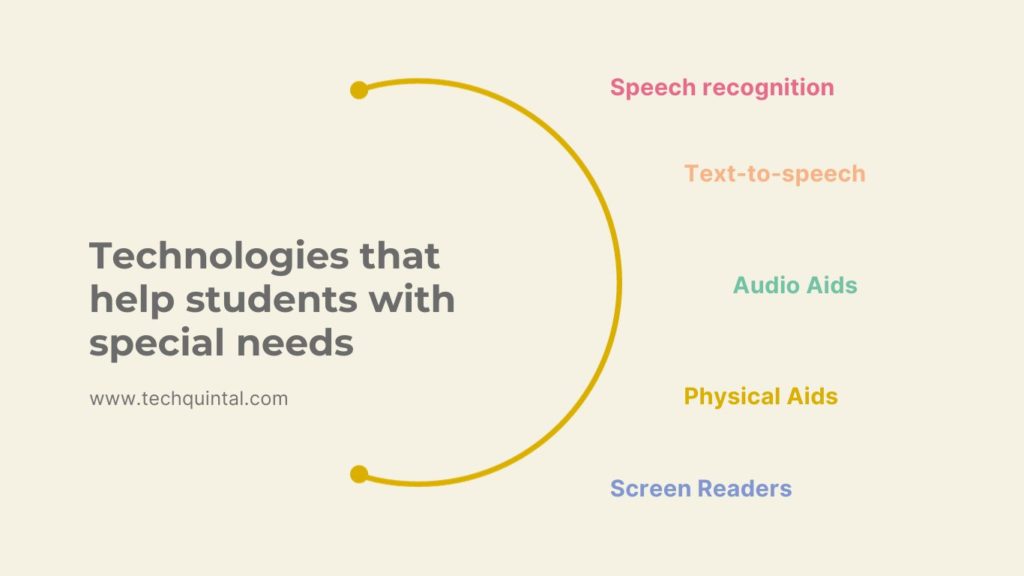
Steven Hawking is the best proof that no one should be barred from obtaining an education. His use of, at the time, advanced modern technology, allowed him to attend school, study, and graduate. Afterward, it provided him with a way to document and publish his research and interact with others. But his difficulties are only a drop in the bucket. New technologies are invented to allow equal access, comfort, and independence for individuals with difficulties and disabilities. That’s exactly what we analyze below – how technology can help differently abled students.
What is assistive technology?
First, we must define assistive technology, as the topic of our discussion. And what better way than the United States’ Assistive Technology Act (1998)? It states the following:
“Assistive technology is any item, piece of equipment, or product system, whether acquired commercially off the shelf, modified, or customized, that is used to increase, maintain, or improve functional capabilities of individuals with disabilities. Assistive technology service is directly assisting an individual with a disability in the selection, acquisition, or use of an assistive technology device.”

Benefits of Assistive Technology
Assistive technology is beneficial to students with special needs, especially in their formative years. Access to such technology is often considered the first step towards their overall development.
Since such students face additional challenges, it is important that they maintain access to technology that can aid them throughout their lives. Recognizing this fact, many schools have started incorporating assistive technology.
In fact, a survey by Washington.edu shows that around 55% to 64% of schools that serve students with special needs have already made the transition to either technology or other assistive products, such as software. Students can benefit from such adaptations in various ways, including:
- They can gain social and technical skills that can make them independent.
- They can approach a higher level of education without feeling inadequate.
- With increased access, they can improve their communication abilities.
- Assistive technology can also help them interact with their peers without feeling inferior.
- Using this tech can also make students more confident and assertive in general, and it will also help with their self-esteem.
- Furthermore, it can aid their pursuit of academic goals and aspirations.
But that’s not all. With the increase in attention and improved innovation, the future is looking more bright for people with disabilities in general. The following video talks about the implications of innovation in assistive technology and what the future holds:
How Technology Helps Differently Abled Students?

Technology aids differently-abled students by providing adaptive tools, like speech-to-text software and adjustable text sizes, which can facilitate learning and communication. Interactive educational platforms and virtual reality technologies also offer immersive and personalized experiences. These are some ways technology helps differently abled students:
1. Physical impairments
Students who have physical difficulties need assistance leading normal lives, and movement is a major part of it. That provides an apparent way technology can help differently abled students. We’re referring to the invention and application of items such as canes, braces, wheelchairs, prosthetic limbs, and very soon, bionic limbs.
Also, have you heard of self-balancing pens and bookstands or anti-tremor keyboard and mouse adapters? Most people didn’t. Well, they are pivotal for students with motor coordination problems. Additionally, if learners cannot be present physically, they can sign up for eLearning schools, and benefit from the advantages of online classes.
Inability to use hands
Early technological advancements allowed students to use other parts of their body, especially the head or feet as an alternative to performing tasks done by hand. Nowadays, if an individual can use their voice, they don’t have to. Improvements in speech-recognition software allow learners to operate their computers and smart devices using their voice.
Moreover, voice-to-text software allows them to “write” essays, keep notes, publish research, and communicate with professors or fellow pupils. Finally, many of the written resources are released in the form of audiobooks.
2. Sensory damage
Assisting students with sensory difficulties is one of the most obvious uses of technology in special education.
Vision
Students with mild visual impairment can benefit from magnification tools built into most modern devices. As an example, we taught you to zoom in and zoom out on PC and how magnification works on Mac. This is also possible on smart devices such as smartphones, tablets, TVs, TV boxes, and more.
The same applies to students who are blind. Every major operating system has a built-in text-to-speech functionality. This allows students to hear everything that appears on the screen, regardless of the type or format. It also allows them to interact with their peers and professors, use e-mails, or receive/convert schoolwork as audio. Although inferior and slower method, learners can also convert on-screen elements to Braille.
Likewise, the rapidly improving translation feature allows translating to or from foreign material to Braille or audio almost in real-time. Actually, this benefits all students.
Hearing
The most obvious example of a sound amplification tool is a hearing aid. While it’s usually placed behind the ear, the introduction of the Cochlear implants created the new-now. This technology made hearing implants safer, cheaper, less invasive, and best of all, invisible.
Students can also install apps on their devices that use visuals (flashing lights, text, icons) instead of sounds to draw their attention. AI-aided speed recognition improvements in transcribing made real-time closed-captioning possible as well. Classrooms and staffrooms equipped with TTY (Text telephone), VCO (Voice Carry Over), and other TDDs (Telecommunication Devices for the Deaf) are also common in today’s world.
Speech
If they suffer from a speech impediment or impairment, students can get access to counseling and management from speed and language therapists. That remains true, but instead of being location-limited, learners can communicate in real-time via the Internet. That means therapy can be done remotely. On the other hand, students who suffer from muteness, now have access to the same text-to-speech software popularized by Steven Hawking.
Moreover, smartphones and computers now act as a more powerful version of speech-generating devices (SGDs). They also have unique features, such as a word-prediction algorithm. Finally, advancements in medical technology might allow for partial or complete restoration of their voice.
3. Cognitive and behavioral difficulties
The rapid expansion of the Internet made students with cognitive difficulties accepted and normalized in the community. It also made online flexible learning, also known as eLearning, not only a possibility but an imperative option.
In fact, it’s undoubtedly the most beneficial application of modern technology in education for them. Students with cognitive difficulties, especially with autism and slower processing speeds, gain just as much as students with behavioral problems.
Why is eLearning technology so effective for them?
Both groups of learners can progress at their own pace and utilize non-conventional learning methods. They also receive much-needed undivided attention and instant help since teachers don’t need to monitor 30-60 students simultaneously. This not only eliminates bullying from peers but also provides positive reinforcement to learn and improve.
Furthermore, attending online courses eliminates the distractions of a typical classroom. This is instrumental for students with severe ADHD, anxiety, depression, or Asperger syndrome which make them differently-abled and unique.
4. Chronic illnesses
Another area where technology can help differently abled students is chronic illnesses. They are often invisible, but take a massive toll if they are severe. Take diabetes for example. If it weren’t for technological advancements in portable blood glucose/ketone monitors, which often sync with the students’ smartphones, some students would be in and out of the hospital rather than listening to lectures.
The same applies to students with advanced heart, lung, liver, or kidney problems. We’re referring to liver function probes/analyzers, hemodialysis and oxygen machines, and Holter monitors. They are portable and allow students not to lead relatively normal lives. In most cases, they can live in dorms or independently, without constant medical care.
5. Personalized Learning
Technology can also enable students to pursue personalized learning, which is much more effective, especially for those with special needs. The course can be modified to keep up with the student, and additional tools can be employed for better understanding.
6. Development of Social Skills
Technology can also help students with disabilities develop social skills, which will be invaluable down the road. Since technology can remove many barriers to communication, it can allow more people with disabilities to join in on any discussion on any topic.
Furthermore, it can help those students with language disabilities, social anxiety or autism spectrum disorder express themselves much more effectively.
7. Professional development
An early onset of technology will only prepare special needs students for the future, especially in their professions, as they will no longer be unfamiliar with tech. It will also help teachers, as they can improve their skill set by exploring better technologies and teaching strategies.
8. Gaining life skills
Finally, students can always gain experience. Integrating technology into their lives will make them much more open to different possibilities, and they can learn many social constructs by themselves.
Different Technologies that help students with special needs

Since we have already covered what assistive technology is, it’s time we take a look at the different types of technologies that can help students with special needs. These are as follows:
- Speech recognition software: Speech-recognition software is software that can recognize speech and turn it into text. Beneficial for those with a visual impairment or physical limitation that prevents the use of a typical input device.
- Text-to-speech software: similar to the previous one but works in reverse as it converts text into speech, which is helpful for those with visual impairments.
- Visual Aids: This is a group of technologies that include screen magnification, inverted color schemes, screen readers, and so on. It is mainly for those who have difficulty seeing things.
- Audio Aids: Another group of technologies consists of things that can aid someone with an ear disability. Technologies include sound amplification tools, alerting devices, TYY or TDD, and voice carryover.
- Physical Aids: It is for those students who have some sort of physical disability, including mobility, stability, or motor control challenges.
Following is a table that lists various technologies that can help special needs students:
| Technology | Description | Benefits |
|---|---|---|
| Assistive Software | Specialized software that can aid a special needs student with his learning process | Personalized learning improves accessibility and independence |
| Speech Recognition | Any tool that converts speech or voice into text | No more need for typing; it helps the visually and physically impaired. |
| Screen Readers | It can read anything on the screen | Beneficial to those with visual impairment |
| Text-to-speech | Can convert text into speech | improves the reading and comprehension abilities of students and helps those with visual impairments. |
| Communication apps | A platform for augmented and alternate forms of communication | Can help those students who have trouble expressing or communicating |
| 3D printing | Can create life-like models | Helps those with sensory impairments and enhances hands-on understanding |